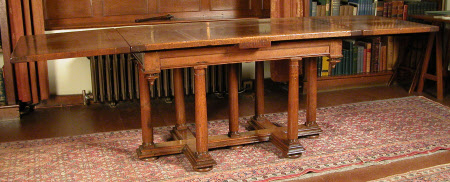Draw-leaf table
Category
Furniture
Date
circa 1850 - 1900
Materials
Walnut, oak
Measurements
78 x 256 (fully extended) x 78 cm
Place of origin
France
Order this imageCollection
Bateman's, East Sussex
NT 760882
Summary
A walnut draw-leaf table, in the French late 16th century manner, made of some period timbers but with replacement/later parts. Probably made/modified in the last half of the 19th century. The central part of the top formed from a single large board of walnut (1 1/4in thick) with cleated ends, and fitted at each end with a smaller board, also with cleats at either end, which, when not in use, slide under and sit beneath the top. The sliding rails of oak. Raised on run-moulded freize rails with blocks at each corner with pendant turned spire finials. Raised on seven ring-turned columnar supports - the central support more slender than the others - all on a moulded platfrom stretcher shaped as a 'croix de Lorraine', fitted with later flattened bun feet.
Full description
There are two examples of this type of table at Bateman's. They are modelled on a distinctive group of late 16th century French tables, all of which have multiple columnar supports and crucifrom stretchers. Like this example, they have a draw-leaf top, a type which was popular from around 1570 to 1620 in France, England and the Low Countries, and thereafter fell out of fashion. Like its counterpart in the Parlour at Bateman's (NT 760851), this table probably incorporates 16th century elements - its top, in particular, is very good, its central section made from one large piece walnut with a square edge - but probably made from 16th century and later timbers, sometime in the 19th century, when these tables seem to have become fashionable once again. Examples of this type of table, which look the part but are not in fact of the period, have been sold at auction by, for instance, Christie's (17 April 2002, Lot 165 and 18 June 2014, Lot 325), where they are dated to the late 19th and early 20th centuries. Rudyard Kipling (1865-1936) worked at this table when at Bateman's. He described the things he kept on it in his autobiography.
Provenance
Listed in 'Mr Kipling's Work Room' as 'A rare old chestnut table 'withdrawe' top...' in the Inventory taken at Bateman's in 1939. Bequeathed by Caroline Starr Balestier, Mrs Rudyard Kipling (1862-1939) with Bateman’s and its contents.


